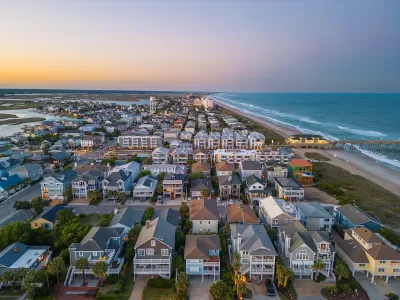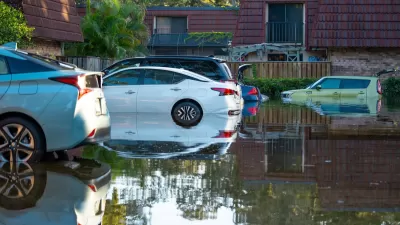Spiking insurance costs in coastal areas prone to climate disasters are making it harder for low-income housing developers to keep building.

Extreme weather driven by climate change is making it increasingly difficult to build affordable housing, reports Kelly Kenoyer in a piece for WHQR. This is largely because insurance companies are hiking premiums or refusing to cover regions prone to natural disasters.
According to one North Carolina affordable housing developer, premiums have gone up by as much as 70 percent. “Coastal North Carolina is a major retirement hub: The two fastest growing counties in the state, Pender and Brunswick, are next door to New Hanover County, and much of that growth is from retirees. Many of those moving have higher incomes than local residents, which helps drive up market-rate rents: and pushes some locals out of their homes, unless they can find subsidized apartments.”
As Kenoyer explains, “That chilling effect hits tax credit developers more than for-profit developers. After all: market rate developers can just increase rents to cover the rising tides of insurance.” Meanwhile, retirees from around the United States continue to move to disaster-prone areas, keeping demand for housing in coastal areas high.
The article notes that the federal government could ease the burden on affordable housing developers by standardizing requirements for the various housing programs used by low-income housing builders and incentivizing building climate-resilient properties.
FULL STORY: Climate-driven insurance hikes are making affordable housing even harder to build

Alabama: Trump Terminates Settlements for Black Communities Harmed By Raw Sewage
Trump deemed the landmark civil rights agreement “illegal DEI and environmental justice policy.”

Planetizen Federal Action Tracker
A weekly monitor of how Trump’s orders and actions are impacting planners and planning in America.

Why Should We Subsidize Public Transportation?
Many public transit agencies face financial stress due to rising costs, declining fare revenue, and declining subsidies. Transit advocates must provide a strong business case for increasing public transit funding.

Understanding Road Diets
An explainer from Momentum highlights the advantages of reducing vehicle lanes in favor of more bike, transit, and pedestrian infrastructure.

New California Law Regulates Warehouse Pollution
A new law tightens building and emissions regulations for large distribution warehouses to mitigate air pollution and traffic in surrounding communities.

Phoenix Announces Opening Date for Light Rail Extension
The South Central extension will connect South Phoenix to downtown and other major hubs starting on June 7.
Urban Design for Planners 1: Software Tools
This six-course series explores essential urban design concepts using open source software and equips planners with the tools they need to participate fully in the urban design process.
Planning for Universal Design
Learn the tools for implementing Universal Design in planning regulations.
Caltrans
Smith Gee Studio
Institute for Housing and Urban Development Studies (IHS)
City of Grandview
Harvard GSD Executive Education
Toledo-Lucas County Plan Commissions
Salt Lake City
NYU Wagner Graduate School of Public Service





























